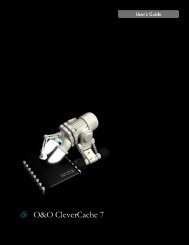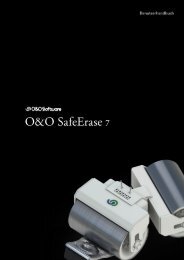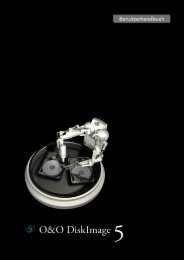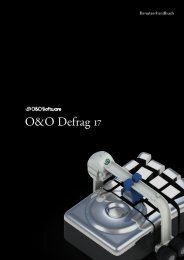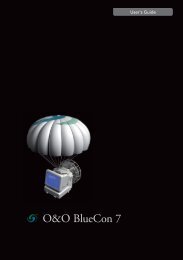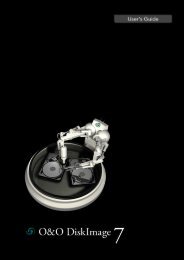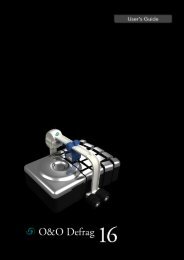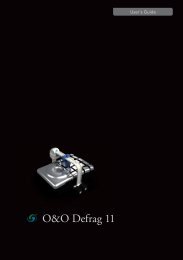O&O Defrag 17 User's Guide - O&O Software
O&O Defrag 17 User's Guide - O&O Software
O&O Defrag 17 User's Guide - O&O Software
Create successful ePaper yourself
Turn your PDF publications into a flip-book with our unique Google optimized e-Paper software.
Technical informationTechnical informationThe following technical information will be helpful when applying O&O <strong>Defrag</strong>:Conflicts with shadow copies during defragmentationThe operating systems Windows 8, Windows 7, Windows Vista, Windows XP64, Windows Server 2003, 2008 and2012 offer users the ability to create "Shadow Copies" for protecting their data. This new feature automatically createscopies of files currently in use at regular time intervals. Since Windows only captures changes in the files, additionalspace is normally not needed. Accidentally deleted files and folders or previous versions of documents can be easilyrestored using a convenient command accessible through the right-click menu. Simply right-click the object you wantto restore and click "Restore Previous Versions".At the moment of installation, Windows Vista, Windows 7 and Windows 8 the shadow copy mechanism is set bydefault. With Windows XP64 and Windows Server 2003/2008/2012 systems it is disabled by default.During defragmentation, files on a volume get moved. Windowsclassifies these operations as a deletion and therefore creates a complete new shadow copy of the moved file. Since alot of files are moved during a defragmentation, a lot of new entries are created in the shadow copies and they take upmore space on your data volume than before the defragmentation. This behavior may overwrite older shadow copieswith newer ones. Unfortunately, this can also lead to the deletion of the system recovery points! These consequencesare most frequent when using the COMPLETE method.Shadow copies are filed in the folder “System Volume Information” and cannot be defragmented. This can end up havinga negative influence on the results of the defragmentation. There is, on the other hand, almost hardly any loss in performancecaused by fragmented shadow copies. Although these files will be displayed as fragmented, they still haveonly a minimal influence on the operating speed of your system.You could disable the shadow copies to achieve improved defragmentation results but you would then wind up losingthe operating system’s built-in backup functionality. That’s why we recommend your leaving the shadow copies enabled.Microsoft is already aware of this problem, as this issue also occurs in the Windows native defragmentation software.More details may be found in this article from Microsoft: http://support.microsoft.com/default.aspx?kbid=312067In Windows XP64 and Windows 2003 Server, this problem will not occur as long as storage volumes have been formattedwith a cluster size of 16KB or larger.Notes concerning the default enabled automatic optimization:Please bear in mind that under Windows 8, 7, Vista, Windows 2003 Server, Windows Server 2008 and WindowsServer 2012 a complete defragmentation of drives that are imaged by shadow copies may lead to losses of oldimage sets. This is a problem known to Microsoft, and these drives are marked accordingly in the O&O <strong>Defrag</strong> userinterface. We therefore recommend running an OPTIMIZE/Complete-defragmentation on large installations onlyand otherwise leaving automatic optimization of O&O <strong>Defrag</strong> enabled.Using the command line versionYou can also control the defragmentation by means of the command line version of O&O <strong>Defrag</strong>. In this way, you canintegrate O&O <strong>Defrag</strong> into scripts that can be run at startup or login.The graphical user interface of O&O <strong>Defrag</strong> will not be shown during a start from the command line. A mini O&O <strong>Defrag</strong>icon will appear in the task tray, and you can follow the progress of the actions in your DOS prompt.O&O <strong>Defrag</strong> runs independently of the main user interface and the DOS prompt in the background. If you close theDOS prompt or cancel the command line tool with Ctrl+Break/Ctrl+C, you can choose whether to end the program orO&O <strong>Defrag</strong> - 65



